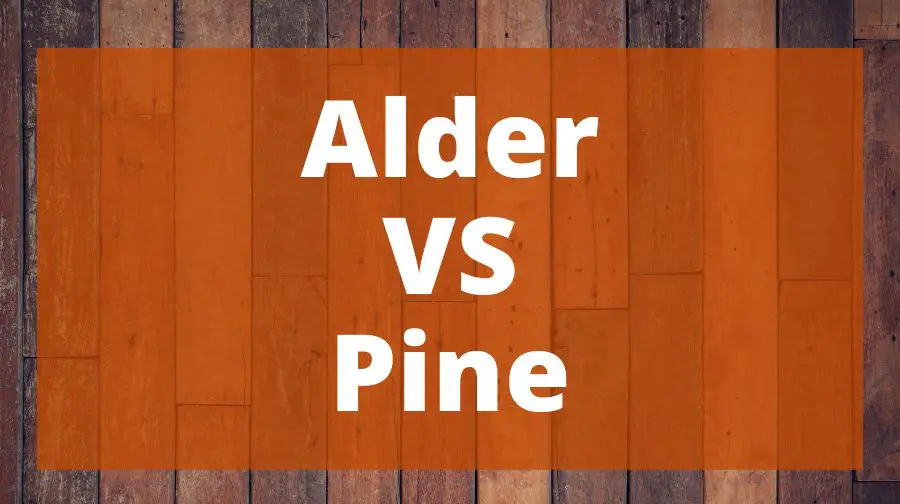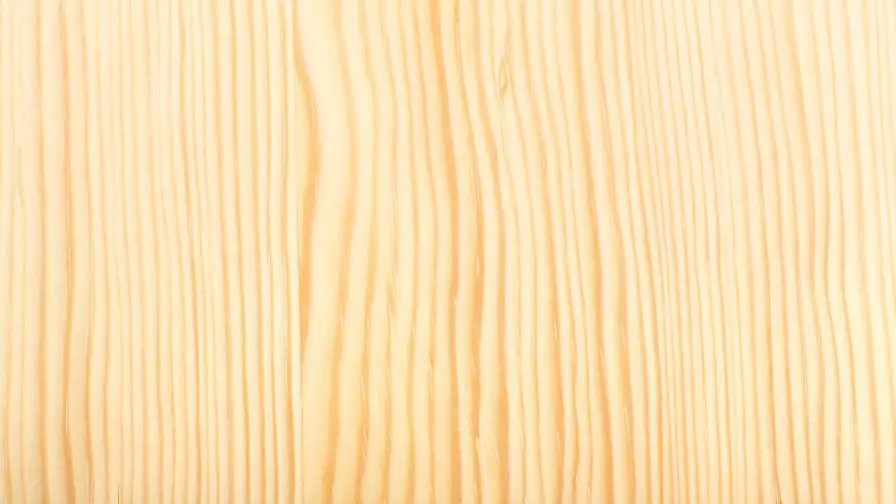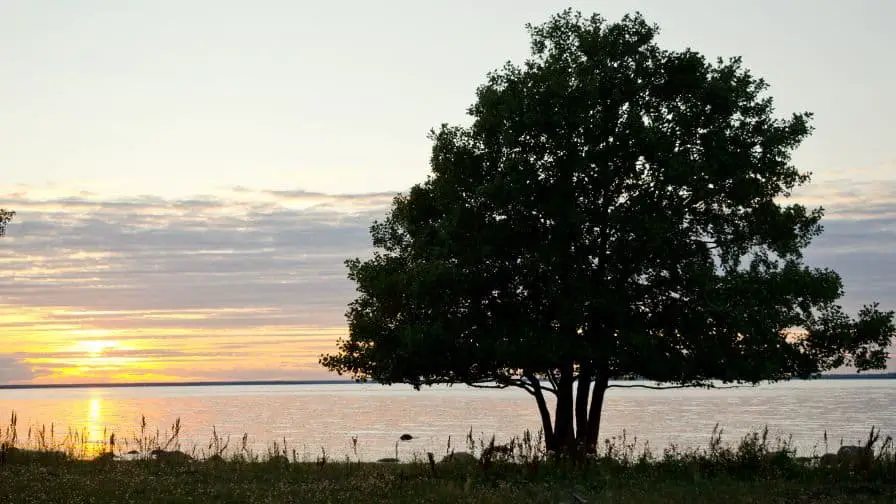
Alder and pine are two of the most popular types of wood for furniture-making. Both have their pros and cons, but which one is the better choice for you?
In this article, we will compare alder vs pine in terms of appearance, strength, price, and environmental impact.
We will also discuss the pros and cons of each type of wood so that you can make an informed decision about which one is best for your needs.
What Is Alder Wood?
Alder wood is a deciduous hardwood that grows in the northern hemisphere. It’s characterized by its light tan to light brown color and straight grain. Alder is a popular choice for furniture, cabinetry, and millwork however, it is not easy to work with as it does not take stains and finishes well.
Alder is a lightweight wood with low density. It’s not as strong as some other hardwoods, but it’s still suitable for many applications. One of the most notable features of the alder is sustainability. It is a relatively sustainable wood. It’s fast-growing and regenerates quickly, making it a good option for those who are looking for an eco-friendly material.

Subscribe to Pondguru on YouTube
What Is Pine Wood?
Pine wood is a type of evergreen tree that is native to North America. The scientific name for pine is Pinus contorta, and there are over 120 different species of pine. Pine trees typically have long, slender needles and produce cones. The wood from pine trees is soft and lightweight, making it a popular choice for construction and furniture-making.
Pine wood is a popular choice for construction and furniture-making because it is soft and lightweight. Pine is also an affordable wood, which makes it a good choice for budget-conscious homeowners. Pine wood is also easy to work with and can be stained or painted to match any decor.
If you’re looking for a beautiful wood that is also affordable, pine may be the right choice for you. Just keep in mind that it’s not as durable as some other options and it may not hold up as well in high-traffic or moist areas.

Subscribe to Mean’s Woodshop on YouTube
Alder Vs Pine – Price
Alder is more expensive than pine because it is more difficult to find and harvest. Alder is also a harder wood, so it takes longer to cut and shape.
Alder is also available in two grades, but they are usually called Knotty and Clear. The knotty alder is less expensive than the clear alder when it comes to labor costs. Clear alder is more difficult to work with because of its density, while pine is easy to work with but can be susceptible to damage. If you are looking for an inexpensive wood that is also easy to work with, knotty alder is your best bet.
Alder Vs Pine – Janka Hardness
The Janka hardness test is a measurement of the resistance of wood to denting and wear. It’s also a good indicator of how hard or easy a wood is to saw or nail. Alder scores a 590 on this scale, while various pine species range from 380- 1630.
Alder Vs Pine – Wood Type
Alder wood species is called Alnus. There are a few different types of alder, but the two most common are red alder (Alnus rubra) and white alder (Alnus rhombifolia). Red alder is the more popular of the two for woodworking projects because it is easier to work with and takes stain and paint well. White alder is more often used in landscaping because it is faster-growing.
Pine trees are evergreen conifers that can grow to be very tall, up to 150 feet (46 meters) tall! There are many different types of pine, but the two most common for woodworking are white pine (Pinus strobus) and sugar pine (Pinus lambertiana). White pine is the softer of the two woods and is easy to work with, but it doesn’t take stain or paint as well as sugar pine. Sugar pine is a bit harder to work with but takes both stain and paint very well.
Alder Vs Pine – Tree Size
In the battle of Alder vs Pine, tree size is an important consideration. Alder trees typically grow to be between 100 and 130 feet tall, while pine trees usually only reach heights of 65 to 100 feet. This means that if you’re looking for a taller tree, an Alder is probably your best bet. However, it’s important to note that tree size can vary depending on the specific species of Alder or Pine. For example, the Giant Sequoia (a type of pine) can grow to be over 300 feet tall!
When it comes to tree size, Alder is the clear winner in the Alder vs Pine battle. So, if you want a taller tree, go with an Alder. If you’re looking for a smaller tree, a Pine might be a better option.
Best Results for Woodworking with Pine Wood
Subscribe to WoodWorkWeb on YouTube
Alder Vs Pine – Location
Alder is common in coastal western North America while pine is more common in inland western North America.
If you’re trying to decide between the two for your next project, it’s important to know where each type of wood grows and thrives.
Alder grows best in moist, well-drained soils but can also tolerate drier soils. Pine prefers well-drained sandy loams but can also tolerate clay soils.
When it comes to location, alder may be the better choice if you’re looking for wood that grows in a wider range of soil types. But if you’re specifically looking for wood that does well in sandy or clay soils, pine may be the better option.
Alder Vs Pine – Color
One of the first things you’ll notice when comparing alder and pine is the color difference. Alder wood has a light tan to a light brown hue, while pine tends to be more of a light reddish brown.
Over time, the color of alder will darken and take on more of a red hue, while pine will stay relatively the same.
Alder Vs Pine – Grain
Alder grain is generally straight, with a moderately fine, uniform texture. This makes it a good choice for many different types of projects.
Pine’s Grain is straight, with a medium, even texture, and a somewhat oily feel. This gives it a more natural look, which can be great for certain projects.
However, it’s important to note that pine is also a softer wood, so it might not be the best choice for everything.
Alder Vs Pine – End Grain
When it comes to end grain, Pine has several medium-sized resin canals that are mostly solitary. These resin canals are evenly distributed throughout the wood. Alder, on the other hand, has no resin canal. This is because it is categorized as hardwood and hardwood doesn’t contain resin.
Pine is considered to be a better wood for end grain because its resin canals help to protect the wood against water damage and rot. Alder is not as durable in this respect, but it is still a good choice for end grain.
How strong is PINE softwood?
Subscribe to Gosforth Handyman on YouTube
Alder Vs Pine – Rot Resistance
Alder is a deciduous tree, meaning it sheds its leaves every autumn. Because of this, the wood is not as dense as pine. This makes alder less durable to rot and pests. Pine, on the other hand, is an evergreen. It has needles instead of leaves and much denser wood grain. This makes pine more resistant to rot and pests. If you’re looking for wood that will last longer without rotting, Alder wood is the better choice.
So, which is the better wood? It depends on what you need it for. If you’re looking for durability, Pine is the way to go. If you need a softer wood that’s easy to work with, Alder is the better choice. Either way, you can’t go wrong with either wood.
Alder Vs Pine – Odor
When it comes to odor, alder has a clear advantage. Pine has a distinct, resinous odor that can be quite overwhelming when working with wood. Alder has no characteristic odor. This makes it a better choice for those who are sensitive to strong smells.
Pine also tends to bleed sap when cut. This can be a mess to clean up and can also stain your clothes. Alder, on the other hand, is a much cleaner wood to work with.
Alder Vs Pine – Sustainability
When it comes to trees and lumber, sustainability is always a hot topic. And rightfully so – we need to be good stewards of our planet’s resources. So when you’re trying to decide between two different types of wood, it’s important to consider the sustainability factor.
Both Alder and Pine woods are sustainable. Alder grows relatively quickly, and Pine is a very renewable resource. However, there are some important distinctions to consider.
Alder is a deciduous tree, which means it sheds its leaves every year. This makes it a more efficient tree when it comes to photosynthesis – the process by which trees convert sunlight into energy. Pine, on the other hand, is an evergreen tree. It keeps its needles year-round, which means it’s not as efficient at photosynthesis.
So when it comes to sustainability, Alder is the clear winner.
Alder Vs Pine – Uses
Alder is a deciduous hardwood that grows in the Pacific Northwest of North America. It’s often used for veneer, plywood, furniture, cabinetry, millwork, pallets, and musical instruments because it takes stain well and has a uniform grain.
Pine is a softwood that grows in the northern hemisphere. It’s often used for utility poles, posts, railroad ties, paper (pulpwood), and construction lumber because it’s durable.
When it comes to uses, alder is better for furniture and cabinetry while pine is better for construction lumber and utility poles.
Alder Vs Pine – Related Species
The Alder related species are the following: Alnus glutinosa (L.) Gaertn. (European alder), Alnus incana (L.) Moench (speckled alder), Alnus rubra Bong. (red alder), and Alnus viridis Chaix ex Vill. (green alder).
The Pine related species are the following: Pinus contorta Dougl. ex Loud. (lodgepole pine), Pinus banksiana Lamb. (jack pine), and Pinus strobus L. (white pine).
- Austrian Pine: A native of the Alps, this pine is known for its dense wood and long needles. It’s often used in construction and is dark green.
- Caribbean Pine: This species is similar to Austrian Pine in terms of density and needle length. It’s also used in construction and has reddish brown heartwood.
- Eastern White Pine: The tallest of all the pines, Eastern White Pine can grow up to 100 feet tall. It’s used in everything from construction to shipbuilding and is light yellow or brown in color.
- Jack Pine: A small pine, Jack Pine only grows to about 50 feet tall. It’s used in construction and is dark green in color.
- Jeffrey Pine: A member of the white pine group, Jeffrey Pine can grow up to 80 feet tall. It’s often used in construction and has a reddish-brown hue.
- Khasi Pine: A native of India, Khasi Pine is known for its dense wood. It’s often used in construction and its sapwood is pale yellow color.
- Limber Pine: A member of the white pine group, Limber Pine can grow up to 60 feet tall. It’s often used in construction and has light brown heartwood.
- Loblolly Pine: A native of the southeastern United States, Loblolly Pine is one of the most commercially important pines. It’s used in everything from construction to paper production and it has yellowish-white sapwood.
- Longleaf Pine: The longest-lived of all the pines, Longleaf Pine can live for up to 500 years. It’s used in construction and has reddish brown heartwood.
- Maritime Pine: A native of Europe, Maritime Pine is known for its resistance to rot. It’s often used in construction and has light reddish brown heartwood.
- Ocote Pine: A native of Mexico, Ocote Pine is known for its durability. It’s often used in construction and has light brown heartwood.
- Patula Pine: A native of South America with sapwood ns pale yellow-white in color.
- Pinyon Pine: A small pine, Pinyon Pine only grows to about 20 feet tall. It’s used in construction and its sapwood is pale in color.
- Pitch Pine: A native of the northeastern United States, Pitch Pine is known for its sticky sap. It’s often used in construction and has reddish brown heartwood.
- Pond Pine: A native of the southeastern United States, Pond Pine is known for its wetland habitat. It’s often used in construction and has pale yellowish heartwood.
- Ponderosa Pine: A native of the western United States, It’s used in everything from construction to furniture making and has reddish brown heartwood.
- Radiata Pine: A native of California, Radiata Pine is known for its fast growth. It’s often used in construction and has light brown or yellow heartwood.
- Red Pine: A native of the northeastern United States, Red Pine is one of the tallest pines, growing up to 100 feet tall. It’s used in construction and has light reddish brown heartwood.
- Sand Pine: A native of the southeastern United States, Sand Pine is known for its sandy soil habitat. It’s often used in construction and has reddish brown heartwood.
- Scots Pine: A native of Europe, the Scots Pine is the national tree of Scotland. It’s used in construction and has light reddish brown heartwood.
- Shortleaf Pine: A native of the southeastern United States, Shortleaf Pine is one of the shortest pines, only growing to about 50 feet tall. It’s used in construction and has reddish brown heartwood.
- Slash Pine: A native of the southeastern United States, Slash Pine is known for its resistance to rot. It’s often used in construction and has reddish brown heartwood.
- Spruce Pine: A native of the southeastern United States, Spruce Pine is known for its resistance to rot. It’s often used in construction and has reddish brown heartwood.
- Sugar Pine: A native of the western United States, Sugar Pine is the largest pine in North America. It’s used in construction and has light brown heartwood.
- White Pine: A native of the northeastern United States, White Pine is one of the tallest pines, growing up to 100 feet tall. It’s used in construction and has pale yellow sapwood.
- Sumatran Pine: A native of Indonesia, Sumatran Pine is known for its resistance to rot. It’s often used in construction and has light reddish brown heartwood.
- Table Mountain Pine: A native of South Africa, Table Mountain Pine is known for its unique shape. It’s often used in construction and has reddish brown heartwood.
- Virginia Pine: A native of the southeastern United States, Virginia Pine is one of the most commercially important pines. It’s used in everything from construction to paper production and it has yellowish sapwood.
- Western White Pine: A native of the western United States, Western White Pine is one of the tallest pines, growing up to 100 feet tall. It’s used in construction and has light reddish brown heartwood.
- Virginia Pine: A native of the southeastern United States, Virginia Pine is one of the most commercially important pines. It’s used in everything from construction to paper production and it has yellowish sapwood.
As you can see, there are a few different options available if you’re looking for wood that’s related to pine. Each has its own unique set of characteristics and can be used for different purposes. Ultimately, it’s up to you to decide which one is the best fit for your needs.
The two species, Alder and Pine, are related to one another through their scientific classification in the plant kingdom. They are both classified as Gymnosperms, which are a group of seed-bearing plants that includes conifers, cycads, and ginkgoes. The Alder is in the family Betulaceae while the Pine is in the family Pinaceae.
Pine wood staining tips and tricks
Subscribe to Tool Review Zone on YouTube
Alder Vs Pine – Pros And Cons
So, which is the better wood: Alder vs Pine? Both kinds of wood have their pros and cons. If you are trying to decide between the two, it depends on your personal preferences.
Here are Alder Wood’s pros:
- Alder is a beautiful light reddish brown wood that looks great in any home.
- Alder is a strong and durable wood, making it ideal for furniture and cabinetry.
- Alder is more affordable than other hardwoods, making it a great option for budget-minded shoppers.
- Alder is easy to work with, making it a good choice for DIY projects.
Meanwhile, Alder Wood’s cons are:
- Alder is not as strong as some other hardwoods, so it may not be the best choice for high-traffic areas or places where the furniture will see a lot of wear and tear.
- Alder may also show scratches and dents more easily than other woods.
Now, let’s take a look at Pine Wood’s pros:
- Pine is a soft wood that is easy to work with, making it ideal for DIY projects.
- Pine has a unique grain pattern that can add character and charm to any space.
- Pine is a strong and durable wood, making it ideal for cabinetry and subflooring.
However, Pine Wood also has its cons:
- Pine is not as strong as some other hardwoods, so it may not be the best choice for high-traffic areas or places where the furniture will see a lot of wear and tear.
- Pine may also show scratches and dents more easily than other woods.
So, which is the better wood: Alder vs Pine? It depends on your personal preferences. Consider the look you are going for and the budget you have to work with. Whichever wood you choose, you can be sure that it will add beauty and value to your home.
What Are The Differences Between Alder Vs Pine?
If you’re considering using wood for a construction project, you may be wondering if Alder or Pine is the better option. Here’s a look at the key differences between these two types of wood:
Alder is a hardwood, while pine is a softwood. This means that alder is more durable and resistant to wear and tear.
Alder is also less likely to warp or shrink than pine. This makes it a better option for projects that require precise measurements, such as cabinets or furniture.
Pine is more affordable than alder. It’s also easier to find since it’s a more popular type of wood.
So, which is the better option? It depends on your needs and budget. If you need durable, warp-resistant wood, Alder is the way to go. But if you’re working with a tight budget, Pine may be the better choice.
What Are The Similarities Between Alder Vs Pine?
First off, both Alder and Pine are coniferous trees. That means they have needles rather than leaves, and they produce their seeds in cones. Both of these woods also tend to be on the softer side, which makes them easy to work with and less likely to cause splinters.
When it comes to looks, alder and pine can also be quite similar. Both kinds of wood can range in color from light to dark brown, and they often have a nice grain pattern. In terms of price, these two kinds of wood are also usually very comparable.

Alder Is Best For:
Alder Wood is best for:
- Making furniture because it is lightweight and easy to work with.
- Staining and painting because the grain is very fine.
- Creates a rustic look because it has a lot of knots.
- Projects that need to be strong and durable, like musical instruments or cabinets.
Pine Is Best For:
Pine Wood is best for:
- Interior trim and molding because it is easy to work with
- Subflooring because it is inexpensive and durable enough.
- Veneers because it is easy to work with.
- Pine is also a good choice for doors because it is durable and can be stained or painted to match your decor.
- Pine is also a good choice for painted projects since it takes paint well and doesn’t show imperfections as much as some other woods.
If you’re looking for wood to use in a high-traffic area or for a piece of furniture that will see a lot of wear and tear, you’ll want to choose a harder wood than Pine and that is Alder. But if you’re looking for inexpensive wood for a project like trim work or molding, pine is a good option.
Is Alder A Cheap Wood?
No, Alder is not as cheap wood as Pine. It’s one of the more expensive woods available for furniture and other woodworking projects. That being said, it is still cheaper than some of the other premium hardwoods like maple or cherry.
So, if you’re looking for quality wood that won’t break the bank, alder is a great option.
Is Alder Wood Soft Or Hard?
Alder wood is a hardwood, but it’s not as strong as some other hardwoods. It’s also not as dense as some softwoods. That makes it a good choice for furniture that will get a lot of use, like chairs and tables.



